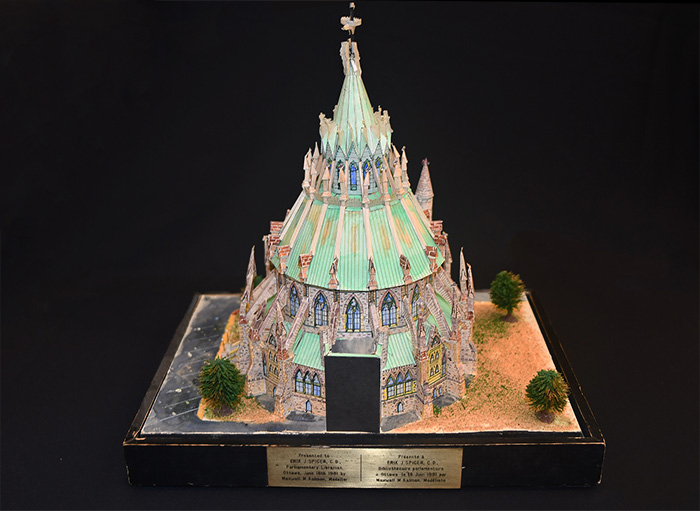The Library of Parliament is a neo-Gothic architectural masterpiece unlike any other. Its imposing rotunda is shaped like a 16-sided polygon, with stone masonry walls topped by a dome that soars more than 40 metres above the floor. With its beauty and grandeur, this building has inspired many artists over the years, including painters and architectural model makers.
Three scale models of the Library of Parliament are currently displayed in one of the Library branches. Even though these models seem tiny compared to the actual size of the building, they offer an impressive glimpse of its architectural details.
In 1981, architect Maxwell M. Kalman crafted a series of scale models of the first Parliament buildings as they looked before they were destroyed by the 1916 fire. He consulted documentation, plans and drawings from the Public Archives of Canada. His designs included a colour model of the Library building using a 1/16 scale, made of paper, that he presented to Erik J. Spicer, the Parliamentary Librarian at the time.
In preparation for the Library renovation, which took place between 2002 and 2006, a highly detailed scale model of the Library of Parliament was created by a group of federal research agencies: the Public Works and Government Services Canada Digital Simulation Laboratory, as well as the Institute for Advanced Manufacturing and the Institute for Information Technology, both of the National Research Council Canada. The scale model was made from a photosensitive resin that was shaped by an ultraviolet laser, using a technique called stereolithography. This technique makes it possible to quickly and accurately create scale reproductions using computerized architectural data.
After the four-year rehabilitation of the Library was completed – including replacing the copper roof, restoring the masonry and ironwork, excavating a space underground, and reinstating the circular desk in the reading room, commonly known as “the ring” – the Digital Simulation Laboratory designed and produced a new scale model. This model offers a cutaway view of the Library’s interior, in which some of these new features can be seen.
In 1976, to celebrate the 100th anniversary of the Library building – the only building to survive the 1916 fire –John Van Dierendonck, the chef of the Parliamentary Restaurant at the time, created a model made out of sugar. This one-of-a-kind scale model remained on display until the Library’s rehabilitation work started in 2002. The fragility of the medium used, however, meant that the scale model could not be preserved.
Details

Scale model made of coloured paper, created by Maxwell M. Kalman. Certain parts, such as small cars, have been removed from the model temporarily for restoration.